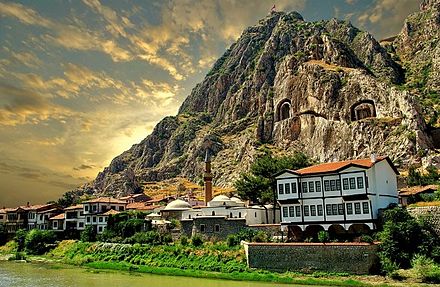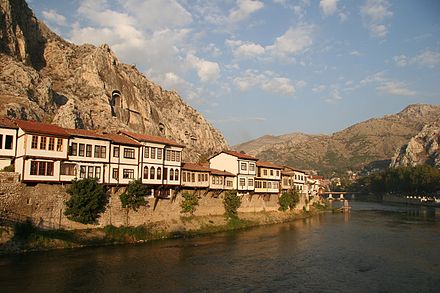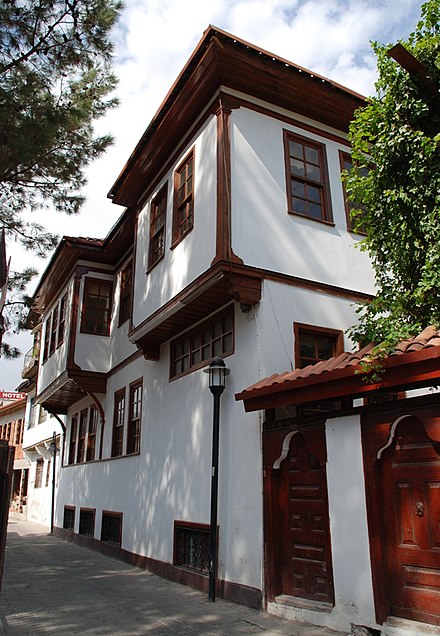Amasya - city in Turkey

Amasya is a city in the Central Karadeniz region of Turkey. It was the hometown of Strabo, an ancient Greek geographer and historian.
Get in
By train
Amasya is on the railway between Sivas and Samsun. This line has been closed for years for track upgrading, and Amasya is cut off from the Turkish railway system.
However the northern part of the line reopened in 2022. One train a day departs Amasya around 06:00, and winds along a scenic route for three hours via Havza, Ladik and Kavak to Samsun on the Black Sea coast. The return train departs from Samsun around 17:30. It's a regional train that can't be booked, buy at the station, 60 TL. Two other daily trains run from Amasya as far as Havza, 75 min.
- Amasya railway station (Amasya Garı). 2020-12-03
By bus
Many bus companies serve Ankara and Istanbul throughout the day. Most of these lines will offer you a free shuttle service to the town square. There are also a few buses every day going to and from Antalya, Çorum, Izmir, Kayseri, Malatya, Tokat and Trabzon.
To come and go from Samsun, the nearest city on the Black Sea coast, there are small Metro minibuses that leave several times a day.
- Bus station, Kirazlıdere Mh. (on the northeastern edge of the city, 2 km from the city center), 40.6634905°, 35.8455569°, +90 358 218 8812. 2020-12-03
Get around
Once you get a bus service or taxi to the town square, everything is within easy walking distance. If you are going on day trips to other places in the province, you can find small privately-owned buses that come and go if you ask around.
For car rentals (if you're interested in a day trip to Hattuşa, the Hittite capital, for example), there is a car rental (and pet!) store very near the train station, and another near the bridge by the Migros supermarket.
See




The major sights of the city include the whitewashed Ottoman houses lining the river and the ancient Pontic rock tombs carved into the side of the mountain overlooking the city.
Harşena hill
High above the city on Harşena hill there is a castle. However, this hill has much more to offer. The climb begins at the Kızlar Sarayı.
- Kızlar Sarayı (Palace of the Maidens), 40.65341°, 35.82967°. The former seat of the Pontic kings, it was also used by the Seljuks but only as an arsenal. Today only ruins of the walls and two baths remain. However a large cafe has been built with a great view over the town.
- Tombs of the Pontic Kings, 40.653601°, 35.830415°. The rock tombs date from around the 2nd century BCE. They make a strong impression being about 12 m high. Beware of a very slippery track leading there. 5 TL
- Amasya Kalesi (Citadel), 40.65528°, 35.82667°. Harşena hill had been used as a fortress since 3000 BCE. The current castle is, however, much younger from about 3rd century BCE. In the Persian period the hill was used as a sacred site that was dedicated to the god of light Ahura Mazda. However, with the Pontic Kingdom as well as during the Hittite period the mountain was again used in as a fortress hill to protect the city. The badly-preserved ruins wouldn't be worth an arduous climb if not for the superb view. A taxi to and from the city center shouldn't cost more than 25 TL roundtrip. Free entrance
Old town
- Büyük-Aga Medrese, 40.658580°, 35.834892°. Located in a working school that was founded in 1488 by the Supreme Eunuch of Sultan Beyazit II Hüseyin Aga. These well-restored buildings and their classrooms are well worth a visit.
- Saat Kulesi (Clock Tower), 40.6528821°, 35.8333692°. The 19th-century clock tower.
- Hatuniye Mahallesi, Hazeranlar Sok, 40.6520938°, 35.8300047°. The old town of Amasya is located at the foot of the mountain just on the riverbanks. A variety of picturesque houses can be found here. The old town used to be protected with defensive walls.
- Haranlar Konagi, 40.652346°, 35.829776°. Tu-Su 08:00 - 16:45 (11:45 - 13:15 break). This house was built in 1483 and has been restored. Now it displays items from the 19th century and an art gallery. 3 TL
City center
Ziya Paşa Bulvarı on the south bank of the Yeşilırmak river has some pleasant waterfront with busts of former crown princes but is still blighted by traffic, as is the parallel shopping street of Mustafa Kemal Paşa Caddesi. Perhaps they will be improved when the bypass is completed. There are many sights from the historical past of Amasya around these two streets. From east to west:
Amasya was a religious and political center for central Anatolia, and there are many small mosques that date back to pre-Ottoman times.
-
Mehmet Paşa Camii (Mehmet Paşa Mosque), 40.6561°, 35.8383°. Mosque built in 1486 by the Vicar son of Beyazit II.
-
Bimarhane (Darüşşifa), 40.65392°, 35.83534°. The house, built during the Mongol period, was the first mental health research facility that used music to treat its patients. For 75 years or so, it had been the home of Amasya's music conservatory but has re-opened as a museum in tribute to the man who undertook research here. 3 TL 2016-07-16
-
Atatürk statue, 40.65213°, 35.83444°. The square in front of it invites you to linger for a while. It is also a local meeting point.
-
Taş Hanı, 40.65044°, 35.831894°. 17th-century caravanserai now an upmarket hotel and restaurant.
-
Burmali Minare Camii (Spiral Minaret Mosque), 40.65025°, 35.832438°. This mosque was built in 1242 for the Emperor Kaichosrew II but was renamed after a 17th-century renovation redesigned the minaret.
-
Vakif Bedesten Kapali çarşı (Covered market), 40.651242°, 35.831651°. This bazaar from 1483 is still in use. The shops sell rather cheap international kitsch (e.g. "I Love NY" - caps).
-
Sultan Beyazıt Külliyesi (Mosque Complex of Sultan Beyazit), 40.650233°, 35.826668°. Prominent on the riverside, Amasya's largest mosque complex was built in 1486 and is dedicated to Beyazid II. It consists of two successively arranged domes and is dominated by two tall differently decorated minarets. Today, the complex also houses the city library (formerly a law school) as well as a soup kitchen and a miniature museum of Amasya. If you decide to splash out the 3 TL for the miniature museum make sure to stay for a full day-night cycle.
-
Amasya Belediye (Municipal) Museum, 40.64948°, 35.82462°. Tu - Su 08:00 - 11:45 and 13:15 - 16:45. A typical local museum, containing objects from the province that date from the early Greek period through the end of the Ottoman dynasty. The star of the exhibition is undoubtedly the statuette of Amasya from the Hittite period. The tomb of the Seljuk Sultan Mesud I can be found in the museum's garden. Of particular note are the mummies from the Mongol period, preserved by the air of their mountain tombs. A bit gruesome but fascinating and unexpected. 5 TL
-
There are two separate wax museums, one dedicated to the 7 Padishahs and one dedicated to Anatolian life in the 16-19th centuries. Like everything else mentioned, they are 3 TL.
-
Şehzade Türbesi (Prince's Tomb), 40.6500°, 35.8237°. Mausoleum that was built for a son of Beyazit I in 1513.
-
Şehzadeler Türbesi (Princes' Tomb). It was built for the sons of Mehmet I, Beyazit I and Beyazit II in 1410.
-
Halifet Gazi Türbesi (Halifet Gazi Tomb), 40.6476°, 35.8147°. Mausoleum that dates back to 1145 and is richly decorated with Medusa's and rams' heads.
-
Gök Medrese, 40.649522°, 35.820252°. This madrasah, built by Seyfeddin Torumtay around 1267 CE, used to be completely covered with blue but not much of that remains today. Its 15 dome construction provides a rather simple interior. Notice the door carvings and the stalactites portal. Two Ilkhane mummies were buried in the building. In front of it there is Torumtay Türbesi (Torumtay Tomb), 40.65071°, 35.82052°. This mausoleum was created for the provincial governor Seyfeddin Torumtay in 1279.
-
There is a "house of suffering" that you can get to if you walk up the hill from the town square, which was an important Alevi pilgrimage spot, as its founder's turbe (tomb) is nearby. You can go into the "suffering house" now that it's no longer in use, and explore the small cells men would live in for months at a time, with little food and water and outside contact, simply reading the Qur'an and meditating on it.
-
Yörgüç Pasa Camisi (Yörgüç Pasa Mosque), 40.650653°, 35.820289°. This mosque was built by the tutors of Sultan Mehmet I Yörgüç. Here you will find a hospital, three tombs and a Madrasah.
-
Fethiye Camii (Fethiye Mosque), 40.647623°, 35.834611°. Built as a church in the 7th century and converted to a mosque in 1117, it was severely fire damaged in 1915.
Surrounding area
- Ayınlı Magara (Mirror Cave), 40.672487°, 35.849253°. Inside this rock tomb there are some wall paintings, as it was used as a church by the Byzantines.
Day trips
- Borabay Golu, 40.804799°, 36.158699°. Small mountain lake 1050 m up at the foot of the 2,062-m Ak Dağı mountain. Due to its location and forested area this is a very popular destination. Camping and trekking are possible. There are picnic tables, chalets, a restaurant and pedal boats.
Geothermal spas
Taking advantage of the North Anatolian Fault there are several geothermal spas in Amasya Province, however those in neighboring Havza and Çorum are more accessible by public transport. If you can't stand the heat of the water in Havza try:
- Gözlek Termal, 40.5517°, 35.6765°. Family business. The outdoor pool, which has a water slide, is only open in the summer from June to September or October. The indoor pools are warm, with some basins and a tiny steam room by each pool, but have no natural light. The men's indoor pool also has 2 mini-waterfalls for neck and shoulders. On a winter weekday morning you will likely have your pool to yourself. Various styles of massage are listed and, guys if you ask for a "kese" the shapely Latif will scrub off the dust of the road, and the lady who does the women's "kese" is also said to be excellent. But they don't seem to have a "göbek taşı" (traditional marble slab for massage). In the flat countryside in late spring you can sometimes see storks nest (not all rooms have views of distant pylons with nests!). Good tea. If you have your own transport and are heading on towards Hattuşa or Sivas this would be a relaxing overnight stop after a day sightseeing. But if cycling, Amasya town traffic may be heavy until the bypass is completed. 2018-11-29
- Fimarlife Thermal Resort Hotel, Terziköy Kaplıca Mevkii Çiviköy (from Amasya it is a few km beyond Gözlek signed "Terziköy Kaplıca"). Large modern spa hotel by the quiet little village of Terziköy. Lots of spa facilities but no very hot pool. Shows off the company marble. 2018-01-06
- Hamamözü Termal Otel. In the small town of Hamamözü this characterful spa was probably luxurious when built but is now in need of maintenance, although it does have a good restaurant and wifi. Has one small hamam each for men and women but only one small swimming pool (women morning and men afternoon) although another is under construction. Tree shaded tea gardens front and back sometimes with live music. Nearby in town is the cheaper new council hamam described below and a small fairly old hamam. 300 TL per double room per night as of 2019 2018-01-06
- Hamamözü Arkutbey Kaplıcalara. open until 22:00. In the small town of Hamamözü this rectangular building with a modern exterior was built in the late 2010s and belongs to the local council (although confusingly as of 2019 the government website above only seems to show the private sector hotel listed above). Has one small 40 °C circular hamam each for men and women and a family room. Both handsomely built hamams have a mini-waterfall for neck and shoulders, and are lined with grey marble with traditional hexagonal ceiling and skylights in a high dome. There are small side rooms off the hamam, also in grey marble, one where you can wash yourself and the other where you can ask for a kese (scrub). Although the scrub is very relaxing it would be nice if the ceiling of that room (off the men's hamam) could be made more interesting and the boring striplight replaced with more atmospheric lighting. The tree shaded Çınarağaç Cafe outside is good for replacing the fluids you will have sweated out and chatting to locals, just be sure to wear socks and long trousers to thwart the occasional foot-biting fly. Although the hamam itself has no accommodation there is more than one small hotel or pension nearby. 13 TL for entry to hamam, 20 TL optional kese (scrub) both as of 2019 2019-09-16
Do
- Stroll along the river walk along with Amasya's townspeople. In the summer months, the street is closed at night because so many people are out.
- Amasya has several very old, nice hamams. They are all single-sex, open to men from 06:00-10:00, women 10:00-17:00, and men again 17:00-00:00. There are special days in the week for working women to come at night, and the weekends are generally reserved entirely for men. Check with the hamams ahead of time; if you are staying at a hotel they can call and ask for you.
- Mustafa Bey hamami, 40.654172°, 35.835589°. A beautifully restored building that includes a Swiss-style sauna room, and has service as good as any hamam in Istanbul for half the price.
- Yildiz hamam, 40.652029°, 35.829152°.
- Kumacik hamam, 40.657478°, 35.836291°. A small hamam which boasts a pool.
- Hiking. Mountains surround the city on all sides and can easily be walked.
Buy
Eat
- Anadolu Mantı Evi, Hatuniye Mahallesi, Hazeranlar Sk. No:57. Mantı is a kind of homemade pasta with various toppings. This is a friendly little place for a light meal if you like (or have not tried yet) it. 2018-01-04
Drink
Generally, all the places in Amasya to go out at night have live music, with the exception of the three or four pubs.
Ali Kaya overlooks the entire city on its southeastern side, and offers great views at night. Mostly plays Turku, Turkish folk music, with a combination of classical and modern instruments.
Eylul Bugusu, Grand Pasha, Emin Efendi and Mithridat are all basically indistinguishable bars and restaurants in the old part of town. You come, get a table, and drink or eat there while listening to covers of Turkish pop or folk music, depending on the night. If you are there on a weekend, a reservation may be required. If you're traveling around the old city during the day, the best thing to do is pop in the various local joints, pick which one suits your taste the most, and ask for a reservation.
For Turkish tea time, there is a local chain called Yesil Ev (green house) that you'll see around town. For a more interesting experience the Municipal Tea garden is on the riverside near the clock tower: at night in the warm months there is generally live music. If you are a large party and you'd like to relax for a while, order the Semaver Cay which is the Turkish version of the Russian Samovar, and you'll be drinking tea for hours. According to locals, though, the best tea and Turkish coffee is to be found at Gamasuk Cay Evi, which is on the main road, Mustafa Kemal Ataturk Caddesi, called Ust caddesi (high street) by locals. Men and women are welcome at all of these places.
Sleep
- Konfor Palas Oteli, Ziya Pasa Bulvari in the city center. A budget place
- Kahvecioglu Otel, on the riverfront, southern side. Free wifi, breakfast, great views from rooms overlooking promenade, central location, friendly staff. Another budget place
Go next
Amasya
amasya.bel.trAmasya
Primary administrative division
